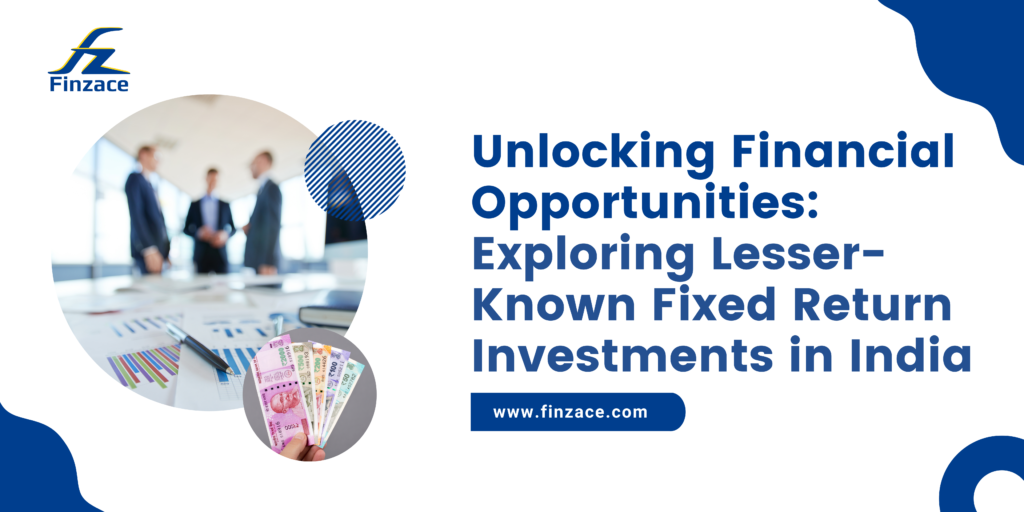In the ever-evolving Indian financial landscape, where traditional fixed deposits and government bonds hold a dominant position, exploring lesser-known avenues for securing fixed return can be a strategic move for investors seeking stability and predictability. While these established options offer peace of mind, they might not always cater to the diverse risk appetites and financial goals of individuals.
This blog delves into the world of lesser-known fixed-return investments in India, empowering you to make informed decisions and unlock new financial opportunities. We’ll navigate through a range of instruments, exploring their features, benefits, and potential drawbacks to help you craft a well-rounded investment portfolio.
The Allure of Fixed Return
Fixed-return investments provide a sense of security. Unlike equity markets with their inherent volatility, fixed-return instruments offer a predetermined interest rate or return on your investment. This predictability allows for financial planning and budgeting with greater ease.
Fixed Return Beyond the Usual Suspects
While Fixed Deposits (FDs) and government bonds are reliable options, they might not always yield the highest returns.
Let’s explore some lesser-known yet promising best fixed-return investments in India:
- Company Fixed Deposits (FDs):
Many companies, particularly those with a strong financial track record, issue fixed deposits. These Corporate FDs can offer competitive interest rates compared to traditional bank FDs. However, it’s crucial to assess the company’s creditworthiness before investing. Opting for established companies with a high credit rating mitigates risk.
- Public Provident Fund (PPF):
A government-backed scheme, the Public Provident Fund (PPF) offers attractive interest rates along with tax benefits. Investments in PPF qualify for tax deductions under Section 80C of the Income Tax Act, of 1961. Additionally, the interest earned and the maturity amount are also tax-exempt. However, PPF comes with a lock-in period of 15 years, with limited withdrawal options before maturity.
- National Savings Certificate (NSC):
Another tax-saving government scheme, the National Savings Certificate (NCS) offers guaranteed returns over a fixed maturity period. They come in various denominations and offer tax benefits similar to PPF. However, premature encashment might lead to interest penalties.
- Senior Citizen Savings Scheme (SCSS):
Catering specifically to the financial needs of senior citizens, SCSS offers higher interest rates than regular bank FDs. It is a low-risk investment with a government guarantee. However, the scheme has investment limits and is only available to individuals above 60 years of age.
- Monthly Income Schemes (MIS):
Offered by banks and post offices, MIS provides investors with a fixed monthly income throughout the investment tenure. This option caters to individuals seeking regular income flow. However, the interest rates might be lower compared to other fixed-return instruments.
- Bank Bonds:
Banks occasionally issue bonds with fixed interest rates and maturities. These bonds can be a good alternative to FDs, offering potentially higher returns. However, their liquidity might be lower compared to bank deposits.
- Tax-Free Bonds:
Issued by government entities or public sector companies, these bonds offer tax-exempt interest income. They are a good option for investors in higher tax brackets. However, their liquidity might be limited, and they might come with lock-in periods.
Choosing the Right Fit
With a plethora of options available, selecting the best fixed-return investment options requires careful consideration of your financial goals, risk tolerance, and investment horizon. Here are some key factors to ponder:
- Investment Horizon: How long are you willing to invest your money? Match your investment horizon with the maturity period of the instrument.
- Risk Tolerance: How comfortable are you with potential fluctuations in returns? Opt for low-risk options if you prioritize capital preservation.
- Financial Goals: Are you saving for retirement, a child’s education, or a down payment on a house? Choose an investment that aligns with your long-term goals.
- Tax Benefits: Consider the tax implications of each investment option.
Beyond Returns: Diversification Is Key
While fixed-return investments offer stability, it’s wise to diversify your portfolio to achieve a healthy balance between risk and reward. Consider including equity-linked instruments or mutual funds with a track record of consistent returns for potential growth alongside your low risk fixed-income options.
Where does FINZACE stand?
Finzace positions itself as a platform for making alternative asset classes, typically reserved for high net-worth individuals, accessible to a wider audience in India. Here’s a breakdown of Finzace’s approach to high return fixed income investments:
- Focus on Alternative Investments: We aim to provide access to asset classes beyond traditional stocks and bonds, potentially offering higher returns.
- The promise of High Returns: We provide fixed returns of 12% or more, though it’s important to understand the associated risks.
- Technology-driven Platform: We use AI for portfolio diversification and potentially higher returns.

